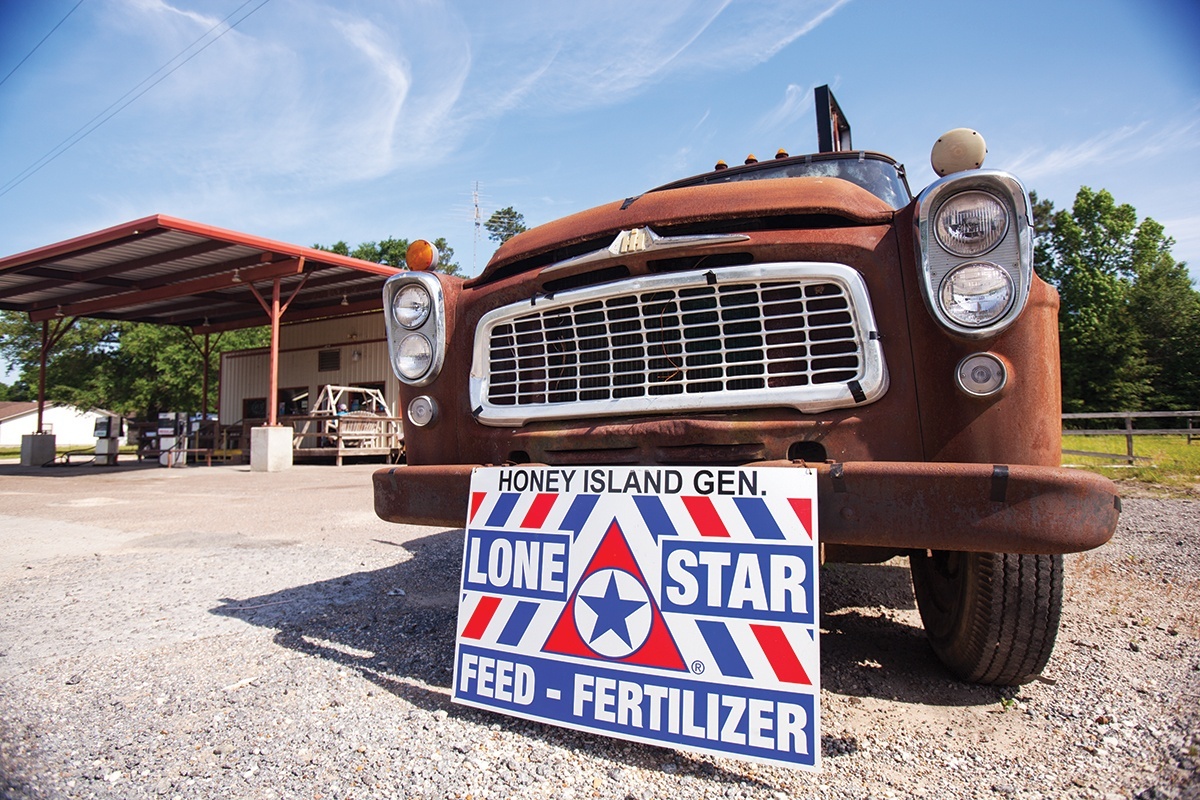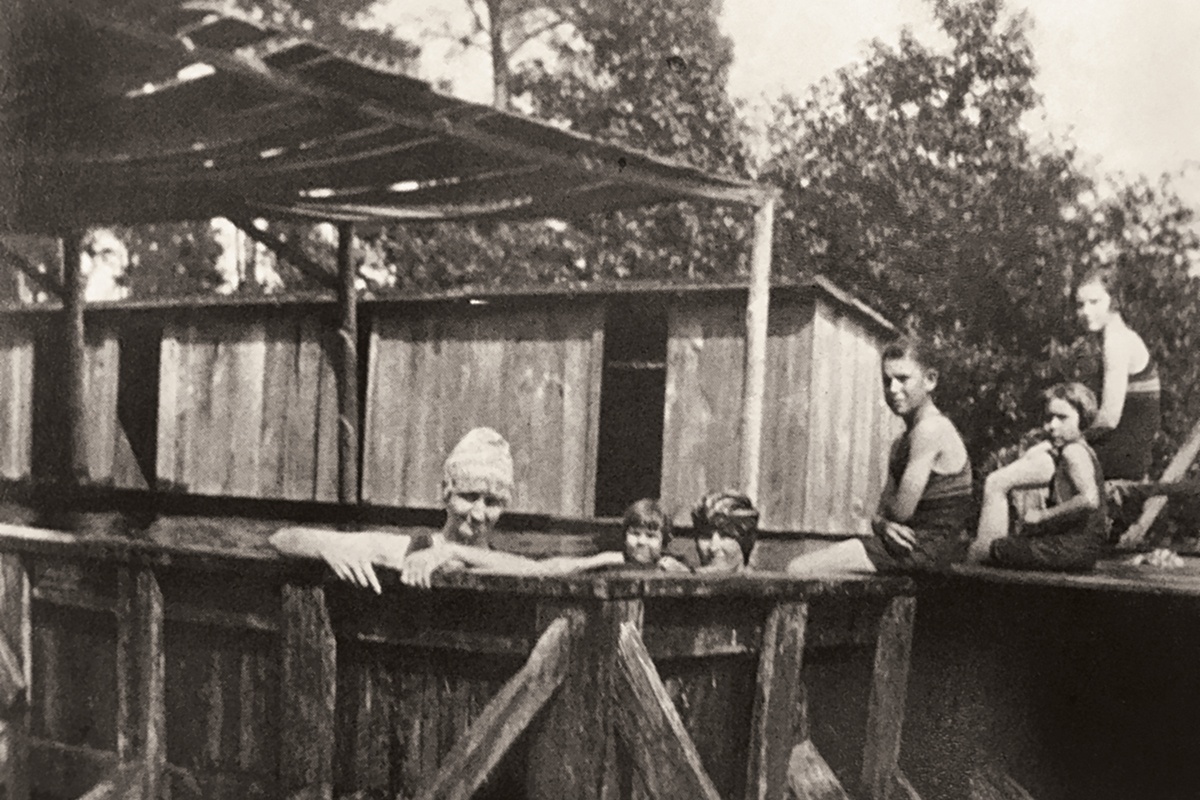Stop by the Honey Island General Store almost any week, and you’ll find locals and Big Thicket tourists rubbing elbows at the store’s cafe over hearty breakfasts and juicy burgers. Some take time to peruse the store’s shelves, filled with everything from grocery goods and plumbing supplies to deer corn and rubber boots—and, yes, even jars of local honey. It’s an old-fashioned general store in the tradition of mercantile emporiums of yore, says owner Chuck Turner.
“The idea is to offer folks most of what they need right here close to home,” Turner says.
Shoppers may not know it, but Honey Island General Store also is a historical touchstone. Built in 1937, the store is just about the only thing left of a once-bustling community with a rich history reaching back to pioneer times.
Eavesdrop on conversations around the store, and you’ll pick up clues about Honey Island’s storied past.
“People come by all the time asking if any of the old Kirby houses are still around, or if the artesian pool is still open,” says Turner, who grew up in nearby Kountze and serves on the board of Sam Houston Electric Cooperative. He represents District 4, Hardin and Liberty counties.
Turner likes to pull out a more tangible remnant—a Honey Island School yearbook, The Echo, dating from the mid-1950s. That always rekindles the memories of old-timers who grew up here about the days before the mill closed, the school withered, and the community emptied of residents.

Honey Island General Store serves local families with “a little bit of everything,” says owner Chuck Turner. This 1958 International one-ton truck was used decades ago to power an electric generator at the store when storms knocked out power service.
Randy Mallory
The story of Honey Island—some parts fact, some parts legend—begins, as do most aspects of life in the Big Thicket, in the woods. Frontier families from the South moved to a wedge of elevated land between Cypress and Flat Cypress creeks that rose during heavy rain to form a temporary island. During the Civil War, an estimated 75 local men resisted service in the Confederate army and hid out in the dense thicket.
“Back then, everybody was poor here, both blacks and whites, just trying to survive,” Turner says. “So as far as the war went, many families just didn’t have a dog in that hunt.”
That live-and-let-live attitude drove the resisters—or Jayhawkers, as they were known—to hide from authorities by eating honey found in trees deep in the woods and by trading pots of honey for needed supplies left by supporters. Confederate Captain James Kaiser tried to burn out the Jayhawkers by setting the woods on fire, an episode known as the Kaiser Burnout. Geography and history intersected for a name that stuck: Honey Island.
At the turn of the 20th century, the Gulf, Colorado and Santa Fe Railway made it to the deep woods, setting up a train station called Matile. Timber interests followed the rails, and by 1907, the Matile Lumber Company was milling logs into lumber not far from a newly built Honey Island post office. (The Kirby Lumber Company later bought the Honey Island mill.)
About that same time, one entrepreneur noticed natural gas bubbling up in local ponds and dreamed of an oil well gusher like the recent one at Spindletop, near Beaumont. The results of a test well, drilled more than 1,900 feet deep just south of Honey Island, resulted not in gushing oil but in an inexhaustible supply of 108-degree artesian mineral water flowing at 10,000 barrels a day.
The artesian well was so strong, in fact, that it pushed water uphill through a 2-inch pipe for more than 2 miles to the Honey Island mill. By 1914, the landowners, Jake and Annie Lloyd, captured some of the artesian water in a wooden aboveground pool, which quickly became a local attraction. The Brackin family (sometimes spelled Bracken) bought the site, which eventually boasted two large poured-concrete pools, plus picnicking and camping areas. Near the picnic area stood a pioneer cabin housing a small museum. It was the home of Uncle Bud Brackin, champion Big Thicket bear hunter, who claimed to kill more than 300 bears from 1875 to 1912 in order to feed his family.
Times were tough around Honey Island in the 1930s, during the Great Depression. The Kirby Lumber Mill closed for a few years. Economic woes eased somewhat with the establishment in 1933 of a Civilian Conservation Corps camp across the road from the Honey Island pool. There, 167 young men were paid by federal recovery dollars to clear abandoned tram roads, once used to haul timber out of the woods, and to create firebreaks and allow access for U.S. Forest Service crews to fight fires. On weekends, the CCC workers swarmed the Honey Island pool pavilion to dance with local girls to the music of live bands.
The Honey Island swimming pool attracted families from across the region, says Louis Williams, lifelong Honey Island resident who worked at the pool.
“We opened the last weekend in April and closed on Labor Day,” Williams says. “There were two diving boards and a slide. We had family reunions and church groups, and schools scheduled pool days for the kids. There was no drinking allowed, so it was a great family atmosphere.”
Hardin County historian Renée Hart Wells of Lumberton fondly recalls family weekend outings at the pool.
“We’d meet our cousins there to swim, even though the concrete pool was so rough you’d skin your knees,” Wells says. “I remember sitting under the dance pavilion watching my parents dance to jukebox music. I’d beg Dad to let me stand on his shoes so we could dance together!”
The pool closed in 1999 but still flows as strong as ever, reports owner Sharon Bracken, who says the water remains the purest ever tested in Texas.
After the Great Depression, the Kirby mill reopened at Honey Island and ramped up production. By 1939, the trade publication Gulf Coast Lumberman noted that “the Kirby forests near Honey Island contain sufficient of their own timber to keep that mill slashing away for probably a generation to come.” The writer described Honey Island this way: “One of the most attractive small town schools in all East Texas graces a greensward across the lake from the mill, and they are now preparing to spend a considerable sum of money building a very modern and attractive Community Center building close to the school.”
In addition to the school, Honey Island featured a company-owned store and homes built specifically for Kirby workers. Eventually, the town sported half a dozen stores, a skating rink and a movie theater next to today’s Honey Island General Store, explains Turner, who bought the venerable store in 1990. The population of Honey Island peaked around 1950. That’s when the Kirby mill employed 350 workers and reached a capacity of 150,000 board feet of cut timber per day. As timber supplies dwindled, the Kirby mill closed in 1955. Its workers moved to the company’s Silsbee operation, draining Honey Island of people. The 1950 census showed 1,250 inhabitants in Honey Island, but by 1990, it dropped to 400.
“The old Kirby houses were sold off and moved by the new owners. The Honey Island post office was cut into pieces and made into homes,” Turner says. “The old school gym became a church. And, of course, the famous swimming pool closed.” Decades later, people from all over the region still drop by Honey Island, he adds, just to remember where their ancestors worked, lived and played.




